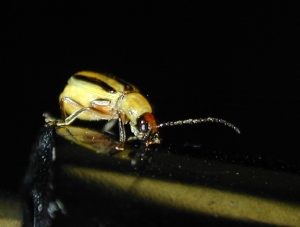Written by Stephanie Gorski
Hi, I started this series to explain a little more background behind the news and opinion articles you may have seen about Bt-resistant corn rootworms, with scary titles like Voracious worm evolves to eat biotech corn engineered to kill it and Evolution one-ups genetic modification. I started out talking about the system as it was originally developed for moths, but I wanted to come back to talk about why rootworms are so good at developing resistance to Bt crops. Part I of this article talked about refuges and how they are used to slow insect resistance, so I’m assuming you know how a refuge works. If you don’t, check out Sex and death in the cornfields: What is a refuge?

There are several different pestiferous species of rootworms, but they are often lumped together because their larvae are difficult to tell apart. The Western corn rootworm (Diabrotica virgifera virgifera) is the most damaging and most studied.
As you may recall, transgenic Bt-expressing corn targeting rootworms has only been around since 2003, and there are already reports of resistance. Resistance has been confirmed in Iowa. Reduced susceptibility has been reported in Colorado, Minnesota, Nebraska, and South Dakota. (Reduced susceptibility is basically the same idea as resistance, but is defined more loosely; there is a lower standard of evidence to meet.) So it looks like there will be more resistance occurring in the near future.
It looks like we haven’t been as effective in slowing resistance development with rootworm-active transgenics as with moth-active transgenics. Why? There are lots of things about the rootworm system that make it less simple and less elegant than the moth system. Continue reading “Sex and death in the cornfields, Part II- Why rootworms?”



